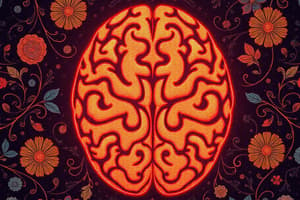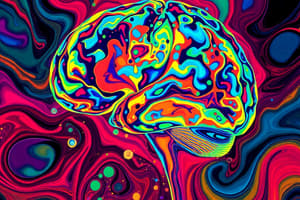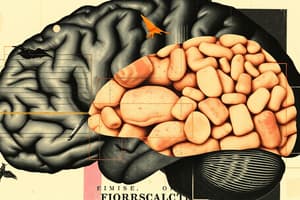Podcast
Questions and Answers
Which of the following brain structures is primarily responsible for processing and regulating emotions, particularly fear and anxiety?
Which of the following brain structures is primarily responsible for processing and regulating emotions, particularly fear and anxiety?
Which brain structure is involved in the regulation of motivation, emotion, and learning?
Which brain structure is involved in the regulation of motivation, emotion, and learning?
Which of the following brain regions is critical for the fluidity of movement and inhibiting movements through dopamine?
Which of the following brain regions is critical for the fluidity of movement and inhibiting movements through dopamine?
Which of the following brain structures is involved in motivation and reward learning?
Which of the following brain structures is involved in motivation and reward learning?
Signup and view all the answers
Which brain lobe is responsible for processing visual information?
Which brain lobe is responsible for processing visual information?
Signup and view all the answers
Which of the following brain structures serves as a relay station for incoming sensory information?
Which of the following brain structures serves as a relay station for incoming sensory information?
Signup and view all the answers
Which of the following brain regions is responsible for complex functions like consciousness, language, and thought?
Which of the following brain regions is responsible for complex functions like consciousness, language, and thought?
Signup and view all the answers
Which brain structure is most directly involved in the control of the endocrine system?
Which brain structure is most directly involved in the control of the endocrine system?
Signup and view all the answers
Which lobe of the brain is responsible for higher intellectual thinking?
Which lobe of the brain is responsible for higher intellectual thinking?
Signup and view all the answers
What is the main function of the corpus callosum?
What is the main function of the corpus callosum?
Signup and view all the answers
What is the primary function of interneurons?
What is the primary function of interneurons?
Signup and view all the answers
Which type of glia is responsible for providing myelin to neurons?
Which type of glia is responsible for providing myelin to neurons?
Signup and view all the answers
What happens to a neuron during an action potential?
What happens to a neuron during an action potential?
Signup and view all the answers
What neurological condition is characterized by difficulty understanding language?
What neurological condition is characterized by difficulty understanding language?
Signup and view all the answers
Which of the following is NOT a function of the prefrontal lobe?
Which of the following is NOT a function of the prefrontal lobe?
Signup and view all the answers
What is the state of a neuron at rest?
What is the state of a neuron at rest?
Signup and view all the answers
Which neuroimaging technique allows for visualizing bones?
Which neuroimaging technique allows for visualizing bones?
Signup and view all the answers
What is the primary function of the medulla?
What is the primary function of the medulla?
Signup and view all the answers
Which neuroimaging technique is considered cheaper and faster than PET scans, while also providing better resolution?
Which neuroimaging technique is considered cheaper and faster than PET scans, while also providing better resolution?
Signup and view all the answers
What is the primary function of the reticular formation?
What is the primary function of the reticular formation?
Signup and view all the answers
Which neuroimaging technique is used to visualize blood vessels?
Which neuroimaging technique is used to visualize blood vessels?
Signup and view all the answers
What is the term used for techniques that provide visual images of brain activity and structure in awake humans?
What is the term used for techniques that provide visual images of brain activity and structure in awake humans?
Signup and view all the answers
Which of the following neuroimaging techniques requires the patient to drink a radioactive substance?
Which of the following neuroimaging techniques requires the patient to drink a radioactive substance?
Signup and view all the answers
Flashcards
Neuroimaging
Neuroimaging
Techniques for studying brain activity and structure using visual images.
PET Scan
PET Scan
A scan that shows brain function using radioactive substances.
fMRI
fMRI
Improved brain imaging method that shows functions without radioactive substances.
MRI
MRI
Signup and view all the flashcards
Hindbrain
Hindbrain
Signup and view all the flashcards
Medulla
Medulla
Signup and view all the flashcards
Cerebellum
Cerebellum
Signup and view all the flashcards
Reticular Formation
Reticular Formation
Signup and view all the flashcards
Parietal lobe
Parietal lobe
Signup and view all the flashcards
Frontal lobe
Frontal lobe
Signup and view all the flashcards
Prefrontal lobe
Prefrontal lobe
Signup and view all the flashcards
Broca’s Aphasia
Broca’s Aphasia
Signup and view all the flashcards
Wernicke’s Aphasia
Wernicke’s Aphasia
Signup and view all the flashcards
Corpus Callosum
Corpus Callosum
Signup and view all the flashcards
Neurons
Neurons
Signup and view all the flashcards
Action potential
Action potential
Signup and view all the flashcards
Substantia nigra
Substantia nigra
Signup and view all the flashcards
Limbic system
Limbic system
Signup and view all the flashcards
Amygdala
Amygdala
Signup and view all the flashcards
Hippocampus
Hippocampus
Signup and view all the flashcards
Thalamus
Thalamus
Signup and view all the flashcards
Hypothalamus
Hypothalamus
Signup and view all the flashcards
Cerebral cortex
Cerebral cortex
Signup and view all the flashcards
Basal ganglia
Basal ganglia
Signup and view all the flashcards
Study Notes
Neuroimaging Techniques
- Techniques allow for studying brain activity and structure in awake humans
- Methods include X-Rays (visualizing bones), PET scans (positron emission tomography), fMRI (functional Magnetic Resonance Imaging), MRI (Magnetic Resonance Imaging), and CT/CAT (computed tomography) scans.
PET Scan
- Examines brain function
- Before the scan, a radioactive substance is consumed.
- The scan shows brain regions activated during specific tasks.
fMRI
- Similar to PET scan but superior
- Faster, clearer, higher resolution, cheaper, and no radioactive substance needed.
MRI
- High resolution 3D imaging of the brain
- Shows general brain structure
- Also provides MRA (Magnetic Resonance Angiogram) which displays blood vessels.
CT/CAT Scan
- Uses beams to create images of the patient's body.
Breakdown of Nervous System
- Nervous System components are categorized as Central(CNS), Peripheral (PNS), Autonomic, Somatic, Sympathetic, and Parasympathetic
- The CNS comprises the brain and spinal cord.
- The PNS extends outside of the CNS.
- The autonomic system controls internal organs and glands.
- The somatic system controls external actions, such as skin and muscle movements.
- The sympathetic and parasympathetic sub-systems are subdivisions of the autonomic system, with varying effects (arousing vs. calming functions).
How Reflexes Work
- Simple reflex circuit: sensory neurons send pain signals to the spinal cord.
- Interneurons in the spinal cord synapse with motor neurons.
- The motor neurons signal muscle responses.
- Pain information also travels to the brain, but the process takes longer.
Parts of the Brain: Hindbrain
- Medulla: Regulates heartbeat, breathing, sneezing, and coughing.
- Pons: Connects the medulla and forebrain; crucial for sleep, dreaming, breathing, swallowing, eye movements, and facial expression.
- Cerebellum: Coordinates fine motor skills, balance, and some aspects of perception and cognition.
- Reticular Formation: Regulates sleep and wake cycles, and screens sensory information.
Parts of the Brain: Midbrain
- Substantia Nigra: Crucial for the fluidity of movement and inhibiting movements through dopamine.
- Plays a role in wakefulness, arousal, and mood.
Parts of the Brain: Forebrain
- Limbic System: Involved in motivation, emotion, and learning.
- Amygdala: Processes and regulates emotions, particularly fear and anxiety.
- Hypothalamus: Controls the endocrine system, the autonomic nervous system and various behaviours, like fighting.
- Thalamus: Relays sensory messages to the cortex for processing.
- Hippocampus: Crucial for memory and learning.
- Cerebral Cortex: Outer layer of the brain, responsible for complex behaviours and higher-level mental processes.
- Basal Ganglia: Plays a role in voluntary movement control.
- Nucleus Accumbens: Important for motivation and reward learning (part of the basal ganglia). -Lobes:
- Frontal Lobe: higher intellectual thinking, pre-frontal lobe (planning, personality, memory)
- Parietal Lobe: Sensory information integration
- Temporal Lobe: auditory information processing & language, recognising complex images.
- Occipital Lobe: Processes visual information
Broca's and Wernicke's Aphasia
- Broca's Aphasia: Difficulty producing coherent speech, despite understanding input.
- Wernicke's Aphasia: Difficulty understanding language, despite being able to produce speech.
Corpus Callosum
- The right and left hemispheres of the brain are connected by nerve fibers (corpus callosum)
- Damage to this structure can lead to "split-brain", where the hemispheres act independently.
Neurons
- Neuron: A nerve cell
- Sensory Neurons: Gather sensory information
- Motor Neurons: Communicate information to muscles
- Interneurons: Communiicate with sensory and motor neurons, and other interneurons.
Glia/Neuroglia
- Cells that make up the nervous system, in addition to neurons
- Includes Astroglia (creates blood-brain barrier), Oligodendroglia (speeds up neural transmission), and Microglia (cleans up dead cells and prevents infection)
How Neurons Work (Action Potentials):
- Resting Potential: Neuron at rest, with a negatively charged inside relative to the outside.
- Action Potential: Neuron firing, ions flowing into and out of the neuron, creating a charge shift.
- Nodes of Ranvier: Areas between myelin-coated sections of axons, where the action potential "jumps".
Neurotransmitters and their functions
- Neurotransmitters are chemical messengers that transmit signals across the synapse
- Different neurotransmitters have specific effects
- Certain drugs affect neurotransmitter function.
Neurotransmitter Receptors
- Receptors on post-synaptic cells receive neurotransmitters
- Excitatory postsynaptic potentials (EPSPs) depolarize the neuron, increasing the likelihood of an action potential.
- Inhibitory postsynaptic potentials (IPSPs) hyperpolarize the neuron, decreasing the likelihood of an action potential.
Studying That Suits You
Use AI to generate personalized quizzes and flashcards to suit your learning preferences.
Related Documents
Description
Test your knowledge on various neuroimaging techniques such as PET scans, fMRI, MRI, and CT/CAT scans. This quiz also covers the breakdown of the nervous system components and their functions. Dive into the fascinating world of brain activity and structure study.





